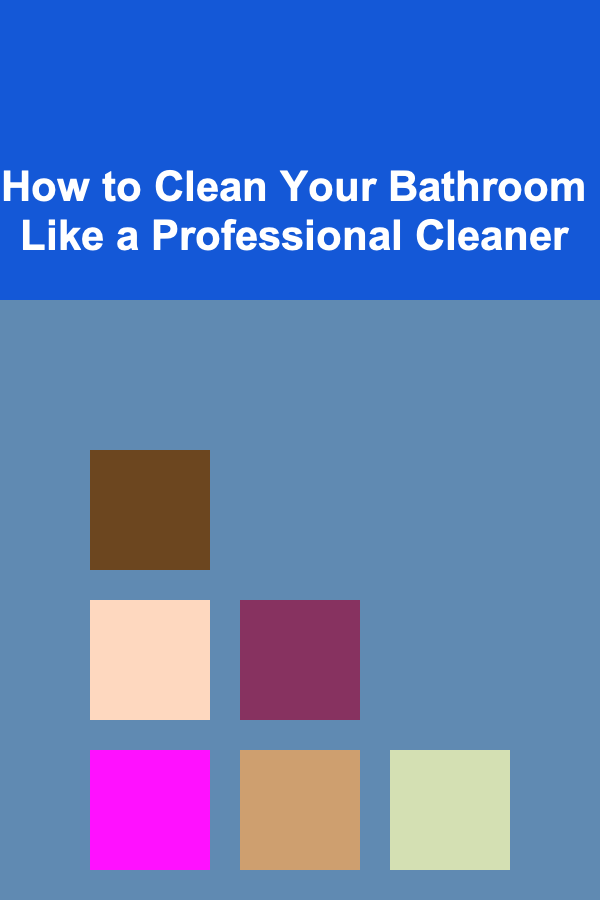
How to Clean Your Bathroom Like a Professional Cleaner
ebook include PDF & Audio bundle (Micro Guide)
$12.99$5.99
Limited Time Offer! Order within the next:

Cleaning a bathroom is one of the most essential yet challenging tasks in maintaining a clean home. It involves a variety of surfaces, fixtures, and materials, all of which require specific cleaning methods and products. Professional cleaners, however, know how to clean a bathroom efficiently, leaving it spotless and fresh. This article will break down the steps and techniques that professional cleaners use to tackle this often daunting task. By adopting these methods, you can transform your bathroom into a sparkling, hygienic sanctuary, just like the experts do.
Step 1: Gather Your Tools and Products
Before diving into the cleaning process, it's crucial to have all the necessary tools and products at hand. Professional cleaners understand that being prepared ensures a smooth and efficient cleaning session. Here's what you'll need:
Essential Cleaning Tools:
- Microfiber Cloths: These are perfect for wiping down surfaces, mirrors, and fixtures without leaving lint behind.
- Scrub Brushes: Various sizes for tackling grout, tiles, and corners.
- Sponges: Non-scratch sponges for delicate surfaces like sinks and tubs.
- Toilet Brush: A specific tool for cleaning the toilet bowl.
- Broom and Dustpan: For sweeping the floor before mopping.
- Mop: A microfiber mop is excellent for cleaning bathroom floors.
Cleaning Products:
- All-Purpose Cleaner: For most surfaces like counters and walls.
- Glass Cleaner: For mirrors and shower doors.
- Disinfectant Spray or Wipes: For sanitizing high-touch areas like faucets, toilet handles, and light switches.
- Grout Cleaner: Specially formulated for grout and tiles.
- Lime or Calcium Remover: Removes water spots, soap scum, and hard water stains from faucets and showerheads.
- Toilet Cleaner: Specifically designed to break down stains and germs inside the toilet bowl.
- Floor Cleaner: A gentle yet effective cleaner for the bathroom floor, whether it's tile, vinyl, or wood.
Professional cleaners are meticulous in selecting the right products for each surface to ensure both cleanliness and the longevity of materials.
Step 2: Declutter and Prepare the Bathroom
One of the first things a professional cleaner will do is to remove any clutter from the bathroom. Not only does this make the cleaning process easier, but it also ensures that every surface is cleaned thoroughly. Here's how to declutter effectively:
- Remove items from countertops and shelves: Toiletries, makeup, and other items can accumulate on bathroom surfaces. Set these aside in a box or basket to be replaced after cleaning.
- Take out towels and bath mats: These items should be washed regularly, and it's best to remove them while you clean to prevent them from getting dirty again.
- Clear the floor: Any rugs or bath mats should be removed so that you can clean the floor properly.
Decluttering before cleaning helps to ensure that every inch of the bathroom is reached and cleaned.
Step 3: Clean High Surfaces First
Professional cleaners follow a top-to-bottom approach. Cleaning high surfaces first helps to prevent dirt and debris from falling onto areas that have already been cleaned. Here's what to focus on:
Clean the Ceiling:
Dust can accumulate on the ceiling, especially around light fixtures and ventilation fans. Using a microfiber cloth or a duster with an extendable pole, dust off the ceiling, light fixtures, and exhaust fan. If your fan has visible dust buildup, give it a wipe down with a damp cloth.
Clean Light Fixtures:
Professional cleaners use a soft microfiber cloth to wipe down light fixtures and ceiling fans to remove dust and cobwebs. If needed, take down the light fixture to wash it, especially if it's a glass bulb or chandelier. Clean the bulbs as well to ensure proper lighting.
Wipe Down Walls and Tiles:
The walls in your bathroom may have accumulated dust, fingerprints, and water spots. Using a damp cloth with all-purpose cleaner, wipe down the walls and tiles. Pay particular attention to areas near sinks, tubs, or showers, as these are more likely to accumulate soap scum and moisture.
If there is visible mildew or mold on the walls, it may be necessary to use a mold and mildew cleaner. Be sure to ventilate the room well during this process.
Step 4: Clean the Mirror and Glass Surfaces
The mirrors in the bathroom often get smeared with toothpaste, soap splashes, and water spots. To get a streak-free shine like a professional cleaner, follow these steps:
Clean the Mirror:
Spray glass cleaner directly onto the mirror or onto a microfiber cloth. Wipe the mirror in circular motions, starting from the top and working your way down. For streak-free results, make sure not to over-spray the glass cleaner. If there are any spots left behind, use a clean, dry microfiber cloth to buff them away.
Clean Shower Doors:
Glass shower doors can accumulate soap scum, hard water stains, and mineral deposits. Professional cleaners use a combination of a glass cleaner and a specialized lime remover to break down these stains. Apply the cleaner, leave it for a few minutes, and then scrub with a sponge or scrub brush. Rinse well with warm water to avoid streaks.
For stubborn spots, a mixture of vinegar and water can be used. Simply spray the solution onto the glass, let it sit for a few minutes, and then wipe it off with a clean cloth.
Step 5: Focus on the Toilet
The toilet is the focal point of any bathroom cleaning routine. A professional cleaner knows how to clean a toilet efficiently while maintaining hygiene. Here's how to clean it like a pro:
Toilet Bowl:
Start by applying toilet cleaner inside the bowl, making sure to cover all areas, including under the rim. Use a toilet brush to scrub the inside of the bowl, focusing on any stains or mineral deposits. Scrub thoroughly along the sides, around the waterline, and under the rim. Let the cleaner sit for a few minutes to disinfect.
After scrubbing, flush the toilet to rinse away the cleaner and germs.
Toilet Exterior:
Use a disinfectant spray or wipes to clean the outside of the toilet, including the seat, lid, tank, and base. Be sure to wipe down high-touch areas like the flush handle and any knobs. Use a microfiber cloth to dry and polish the surfaces after cleaning.
Professional cleaners take extra care with toilet cleaning to ensure that all areas are sanitized, leaving no germs behind.
Step 6: Clean the Sink and Countertops
The sink and countertop area can accumulate soap scum, toothpaste, hair products, and grime. Professional cleaners tackle this area methodically to make it shine:
Clean the Sink:
Use an all-purpose cleaner or a bathroom-specific cleaner to wipe down the sink. Focus on areas around the faucet where toothpaste, soap, and other products tend to accumulate. For stubborn stains or soap scum, use a gentle abrasive cleaner or a vinegar-water solution. Scrub any buildup with a soft sponge or cloth.
Clean Faucets and Handles:
Spray the faucets with a water spot remover or a lime/calcium cleaner. Scrub away water spots using a non-abrasive sponge or cloth. Professional cleaners know the importance of cleaning the faucet handles, as they can harbor bacteria. Wipe down the handles with a disinfectant wipe or spray to kill germs.
Clean Countertops:
Once the sink and faucet are cleaned, wipe down the countertops using an all-purpose cleaner. Be sure to remove any makeup, toothpaste, or other debris that may have accumulated. Pay close attention to corners and edges, where grime can gather. Buff the countertop with a dry cloth to restore its shine.
Step 7: Clean the Tub or Shower
The tub or shower area is where a lot of soap scum, grime, and mold can accumulate. Professional cleaners break this area down into smaller tasks to ensure it's thoroughly cleaned.
Clean the Tub:
If you have a bathtub, start by applying a bathroom cleaner or a mixture of vinegar and baking soda. Spray the cleaner all over the tub and let it sit for 5-10 minutes. Use a scrub brush or sponge to scrub away soap scum and stains. Pay particular attention to corners and seams where mold and mildew can grow. Rinse thoroughly after scrubbing.
Clean the Shower:
For the shower, focus on the walls and floor, where soap scum and water stains accumulate. Use a specialized shower cleaner or a mixture of vinegar and water. If you have grout between tiles, use a grout cleaner and a grout brush to clean those hard-to-reach areas.
For showerheads, professional cleaners often use a mixture of vinegar and water to soak them and break down mineral deposits. If needed, unscrew the showerhead and soak it in the solution for 30 minutes to an hour.
Step 8: Clean the Floor
Once all the surfaces have been cleaned, it's time to tackle the floor. Start by sweeping the floor with a broom or dustpan to remove dust, hair, and debris. Afterward, mop the floor with a bathroom-specific floor cleaner. Use a microfiber mop to gently scrub the floor and remove any dirt buildup.
Pay attention to the corners and edges, where dust and grime can accumulate. If your floor has grout lines, use a grout cleaner or a mixture of baking soda and water to clean those areas.
Step 9: Replace Items and Finish Up
After the bathroom is cleaned, it's time to replace all the items you removed at the start of the process. Here's how to finish up like a professional:
- Replace towels: Hang fresh, clean towels and bath mats back in their places.
- Reorganize toiletries: Place toiletries, makeup, and other bathroom items back in an organized manner.
- Take out the trash: Empty the trash bin and replace the liner.
- Check for missed spots: Before you finish, take a final look around to make sure no area has been overlooked. This is where attention to detail sets professional cleaners apart.
Conclusion
Cleaning a bathroom like a professional requires more than just basic cleaning. It's about using the right tools, products, and techniques to ensure that every surface is spotless and hygienic. By following these steps, you can clean your bathroom efficiently, leaving it fresh, organized, and sanitized. Whether you're preparing for guests, deep cleaning your home, or just maintaining cleanliness, adopting these professional cleaning habits will ensure that your bathroom remains a pristine, inviting space.

How to Decorate a Rental Property Without Losing Your Deposit
Read More
How to Decorate Your Home with Budget-Friendly Plants
Read More
How to Make Your Holiday Decorations Kid-Friendly and Fun
Read More
How to Organize a DIY Craft Party at Home
Read More
How to Use Repurposed Furniture to Create a Chic Living Space
Read More
The Ultimate Guide to Saving Money on Groceries and Reducing Food Waste
Read MoreOther Products

How to Decorate a Rental Property Without Losing Your Deposit
Read More
How to Decorate Your Home with Budget-Friendly Plants
Read More
How to Make Your Holiday Decorations Kid-Friendly and Fun
Read More
How to Organize a DIY Craft Party at Home
Read More
How to Use Repurposed Furniture to Create a Chic Living Space
Read More